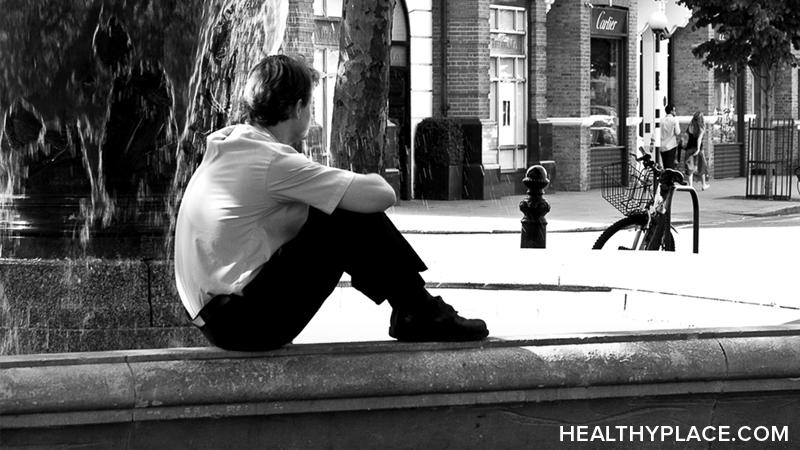Anxiety Makes Us Look for Problems, Distorts Reality

If you live with anxiety, chances are you look for problems. Don't get me wrong. You're most definitely not doing it on purpose. All humans have a built-in negativity bias that causes us to be on alert for danger so we can take action to protect ourselves. Anxiety, in its misguided attempt to keep us safe, usurps that negativity bias and magnifies it, causing us to operate under the assumption that there are problems everywhere.
Unfortunately, this is a distorted sense of reality that can make us feel almost constantly on edge, exhausted, and even physically ill. Once you're aware that anxiety makes you look for problems, you can look for other things instead, and even find joy.
Looking for Problems Because Anxiety Distorts Reality
Because we're looking for problems and worried about things going wrong, people judging us, consequences of past mistakes, or anything else, we naturally want to prevent those things we're concerned about. Anxious thoughts and feelings put us on the lookout for things that are wrong so, in theory, we can make them right and avoid issues. This would be fine if anxiety didn't distort reality.
Anxiety has a way of twisting the way we see ourselves and our world. Think of anxiety as a virtual reality (VR) device that replaces what we see and hear with its own fictitious interpretations. When we're wearing this VR device, we don't interpret things objectively but instead impose our anxious beliefs upon neutral events; we start looking for problems.
Here is just one example of how anxiety distorts reality and causes us to look for problems. You walk into a meeting and sit down. Two people glance at you but then look back down at what they were doing. A few are talking quietly and don't acknowledge you. You sit down awkwardly and think one or more of the following:
- I was right. I'm going to be fired, and everyone already knows it.
- I really made a fool of myself in the breakroom yesterday, and no one wants to be associated with me now.
- I wasn't here early enough. They think I'm lazy and uncommitted to my job. They resent me for having to pick up my slack.
- I'm annoying and no one wants to talk with me.
All of these negative assumptions happened within seconds of entering the room and sitting down. Anxiety pulls you out of the room and into your thoughts about things that already happened, things that might happen, and skewed interpretations of what is happening now. Remove the VR headset, though, and you'll likely see a different, more realistic picture.
Remove Anxiety's VR Device and Be a Neutral Observer
Our thoughts don't always represent reality. We interpret neutral events through our own past experiences, thoughts, feelings, fears, and worries about the future. With all of this judgment clouding the picture, it's very difficult to see clearly.
Here's what a neutral observer would have seen at that meeting:
- Several people sat around a table waiting for a meeting to begin.
- Some talked quietly amongst themselves while others looked at papers in front of them.
- What the people were talking about or studying was unknown, so trying to guess would be pointless and unimportant anyway.
- Someone new walked into the room and sat down (that would be you).
- Two people noticed and returned to what they were doing.
- The others continued to talk so were unaware of or unconcerned about the person who entered and the two others studying what was in front of them.
To this neutral observer, there is no problem. A neutral observer doesn't wear an anxiety-powered VR headset but instead, just notices what's happening. This perspective gives a neutral observer the freedom from having to attach value judgments to everything; therefore, in refraining from trying to attach meaning to everything that happens, a neutral observer experiences much less anxiety.
It takes patience and practice, but we can all learn to become neutral observers. When we do, we no longer see the world through an anxious lens and create skewed interpretations. We can then enjoy a moment for what it is, nothing more and nothing less--and nothing anxious.
I invite you to watch this video for tips on becoming a neutral observer.
APA Reference
Peterson, T.
(2020, August 27). Anxiety Makes Us Look for Problems, Distorts Reality, HealthyPlace. Retrieved
on 2025, December 2 from https://www.healthyplace.com/blogs/anxiety-schmanxiety/2020/8/anxiety-makes-us-look-for-problems-distorts-reality
Author: Tanya J. Peterson, MS, NCC, DAIS
I have been battling my anxiety quiet a bit for the past year. I have book marked this article because it helped me through my morning. I just wanted to say Thank you and I will be looking forward to buying one of your anxiety help books. Which do you recommend first?